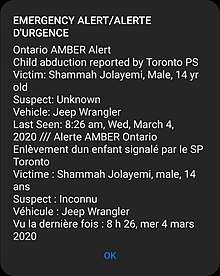Alert Ready
The National Public Alerting System (French: Système national d'alertes à la population),[1] branded as Alert Ready (French: En Alerte), is the national warning system in Canada. The system consists of infrastructure and standards for the presentation and distribution of public alerts issued by government authorities (including Environment and Climate Change Canada and other provincial public safety agencies), such as weather emergencies, AMBER Alerts, and other emergency notifications, by all broadcasters and last mile distributors in the affected region, including television stations, radio stations, television providers, and LTE mobile networks in the affected region. The system is based upon the Common Alerting Protocol, and uses the National Alert Aggregation and Dissemination (NAAD) system operated by Pelmorex Media (owner of The Weather Network) as its backend for distributing alerts to broadcasters, in consort with a style guide that dictates when and how alerts are to be broadcast. Pelmorex also handles public marketing of the system.

In development since 2010, the system officially launched on March 31, 2015; under Canadian Radio-television and Telecommunications Commission (CRTC) rules, all radio and television broadcasters, as well as all digital broadcast distribution undertakings, are required to relay emergency messages issued through NAAD. As of April 2018, wireless providers are also required to participate (Wireless Public Alerting System), utilizing a Canadian variant of the Wireless Emergency Alerts standard adopted in the United States. WPAS is promoted by Pelmorex as part of Alert Ready.
Environment and Climate Change Canada also maintains Weatheradio Canada, which transmits weather information and hazard alerts. Unlike Alert Ready, it utilizes Specific Area Message Encoding (SAME)—the same protocol used by NOAA Weather Radio and the Emergency Alert System in the United States.[2][3]
Alert Ready has faced criticism, particularly due to wireless alerts being handled under a blanket category with no opt-outs (as opposed to the severity-based system used by the U.S. WEA system), and criticism over AMBER Alerts (particularly in Ontario) being issued province-wide rather than geographically targeted to relevant regions. In April 2020, the RCMP faced criticism for not cooperating with local officials in use of the system to warn of an active gunman, which had attacked multiple locations in the province.
History
Proposals
Various attempts had been made in the 21st century to establish a public alert system in Canada, by both departments of government and by television broadcasters. In 2001, Pelmorex, owners of The Weather Network and its French language counterpart MétéoMédia, applied to the CRTC for an amendment to their licenses to encompass a mandatory "All Channel Alert" system, requiring all television providers to relay emergency messages on behalf of governments across all of their channels. The service would have used proprietary hardware developed by Pelmorex, and would have been funded primarily by a $0.13 increase in carriage fees for the two channels. However, its initial proposal was denied by the CRTC, citing the need for consultation with broadcasters, television providers, and other parties on how the system would be designed, along with its costs. There were also concerns over the means in which the system was to be implemented technologically, and that the system was not inclusive to the visually impaired because Pelmorex only specified use of a text crawl, without an audio component.[4][5]
Establishment of such a system in a voluntary form was hampered by CRTC rules at the time, which required television providers to obtain consent from broadcasters before they could overlay emergency notifications onto their programming.[4] In 2005, CRTC called for proposals regarding a national alerting system; Pelmorex and the Canadian Broadcasting Corporation submitted proposals for a national system, while Bell ExpressVu submitted a proposal requesting the removal of the consent requirement. The CBC's proposal would have fed alerts via satellite to decoders installed at local CBC Radio transmitters. It would have allowed television providers to participate on a voluntary basis by installing decoders of their own, if the aforementioned consent requirement were removed. All three applicants promised to adopt the standardized alerting specifications that were developed by the government-backed CANALERT initiative.[4]
While broadcasters and governments supported the proposals for a national alerting system, CTV, Canwest Global and CHUM Limited showed concerns surrounding the Pelmorex proposal, as it would be operated by a for-profit venture that would have the power to override their signals with third-party content, and be redundant to alerts already provided as a public service by some broadcasters. Shaw and Rogers argued that the Pelmorex system was less cost-efficient than the CBC's proposal. It was also disputed whether the CRTC could even order the mandatory distribution of the service, as the CRTC does not regulate alphanumeric content because it is not considered television programming. In 2007, the CRTC removed the consent requirement to ease the adoption of voluntary alerting by broadcast distribution undertakings, but stated that it would reconsider the possibility of a mandatory alert system in the future.[4]
Development
In 2009, the CRTC approved a proposal by Pelmorex to grant must-carry status to The Weather Network and MétéoMédia on digital television services. As part of the proposal, Pelmorex committed to developing a "national aggregator and distributor" (NAAD) of localized emergency alert messages compliant with the Common Alerting Protocol. Pelmorex established a governance council for the system, including representatives of the broadcasting industry, federal government, members of the Senior Officials Responsible for Emergency Management (SOREM), and the Canadian Association for Public Alerting and Notification, to oversee its operations. NAAD would become operational in 2010.[6][7][8]
In a 2011 renewal of the must-carry status, the CRTC praised Pelmorex's work, considering the NAAD system to be "an essential element of a national public alerting system", and expressed an expectation for all broadcasters to voluntarily participate in distributing its alerts. However, as a condition of the renewal, the CRTC ordered Pelmorex to reach agreements with all federal, provincial and territorial emergency management officials to allow them to transmit messages through the system, implement the capability of processing "broadcast intrusive alerts" through the system, and develop a public awareness campaign surrounding the alert system with a budget of at least $1 million per-year.[6][7][8] In June of the same year, the province of Alberta launched a new alerting system of its own, Alberta Emergency Alert, which distributes alerts on radio and television, as well as online and via social networking services.[9][10] This replaced the previous Emergency Public Warning System which had been used since 1992.
Environment Canada, the Canadian Council of Emergency Management Organizations, and the provinces of Manitoba and New Brunswick endorsed the potential use of the NAAD framework as a backend for a mandatory public alerting system.[8][1] On May 26, 2013, SOREM published a "Common Look and Feel" specification for alerts. Developed with guidance from the broadcasting industry, it describes how and when alerts are to be distributed and presented to the public.[1] As part of a license renewal in May 2013, CBC Radio agreed to implement an alerting system using NAAD by December 31, 2014.[11]
On February 27, 2014, the CRTC issued a proposal to mandate participation in the national alert system by all broadcasters. The commission felt that owing to the importance of the endeavour, broadcasters had displayed an inconsistent level of commitment to implement it voluntarily.[1]
Launch
On August 29, 2014, the CRTC ruled that all Canadian broadcasters, including over-the-air television broadcasters, radio broadcasters, and broadcast distribution undertakings, must begin participating in the National Public Alerting System by March 31, 2015. Community, campus, and aboriginal broadcasters were given an extended deadline of March 31, 2016 to implement the system.[6] The National Public Alerting System was launched on March 31, 2015 under the public-facing brand Alert Ready (French: En Alerte).[12]
Bell Satellite TV, MTS, Shaw Direct, and Sogetel do not fully participate in the system, as some of their customers utilize legacy set-top boxes that cannot be updated to support the display of public alerts. They were granted a six-month extension for the implementation deadline by the CRTC in order to address these issues, under the condition that they inform customers that they cannot receive public alerts unless they update their hardware, and must present bi-weekly progress reports to the CRTC. CRTC chairman Jean-Pierre Blais criticized the providers for their inability to properly implement the system, stating that the commission "will not hide our disappointment that certain television service providers are not ready, despite having been given more than enough time [to implement it.]"[13][14]
In December 2015, the CRTC granted an indefinite extension of the exceptions and reporting guidelines to Bell, Shaw Direct, and MTS until they completely phase out hardware that is not compatible with the NPAS. The CRTC felt that the providers had made a good-faith effort in informing customers of their inability to receive public alerts and offering hardware replacements. Bell reported that some customers had declined their offering of a free set-top box replacement as they did not want to participate in receiving alerts. MTS discontinued its legacy "Classic TV" service due to its inability to display alerts, and provided incentives for its remaining customers to upgrade to its current "Ultimate TV" service.[15][16]
Provincial tests began to improve public awareness of the new system, such as in Manitoba,[17] and Quebec. One of the tests in the province on May 19, 2015, simulating a tornado emergency in the Centre-du-Québec region, surprised many people tuned in to radio or TV in the region, leading some to believe that there was an actual tornado emergency.[18]
Mobile alerting

On April 6, 2017, the CRTC required all wireless carriers in Canada to begin relaying public alerts over their LTE and post-LTE wireless networks by April 6, 2018, using Cell Broadcast-based standards by ATIS similar to the U.S. Wireless Emergency Alerts system, collaborating with the SOREM Common Look and Feel guidelines. The CRTC required at least half of devices offered by wireless carriers to support wireless public alerts (including at least one device available at no-charge on-contract, and one "accessible" device) by the implementation date. As of April 2019, all devices sold by wireless carriers must support wireless public alerts.[19][20] The mandate does not apply to networks older than LTE; the CRTC chose to exclude older network technologies (such as 3G) from the mandate, citing wide deployment of LTE networks across the country, and that government funding has been used to support its deployment in underserved areas.[20]
On January 29, 2018, the CRTC informed the Standing Senate Committee on National Security and Defence of concerns surrounding the possibility of false positives (such as a false missile alert in Hawaii earlier that month), and ensuring that the industry meets its goal of at least 50% of devices being capable of receiving mobile alerts by that date.[21][22][23]
Operation
Alert Ready alerts are broadcast to last-mile distributors using the Anik F1R satellite over C-band on virtual channel 206 (with virtual channel 550 as a backup), and prior to September 1, 2019, using the Anik F2 satellite over Ku-band. The Ku-band signals were terminated August 31, 2019 after consultation with the Last Mile Distributors determined that it was underutilized and sufficient alternate services exist.[24] Alerts are also distributed over the internet from web servers based in Oakville and Montreal on TCP port 8080. An RSS feed of past alerts is also available.[25]
The presentation of alerts is dictated by the NPAS Common Look and Feel Guidance. Messages are formatted using the Canadian Profile of the Common Alerting Protocol (CAP-CP), and are provided in at least one of Canada's official languages (either English, French, or both, as determined by local policies and laws). Alerts can contain text and audio components, and contain information designating the region that an alert applies to.[26]
Messages marked with "Broadcast Immediately" flags are used to designate alerts that present "an imminent or unexpected threat to life, that alerting officials wish to be distributed and presented to the public as soon as possible, even if it means disrupting the programming of last mile distributors." On television and radio, relevant alerts marked with this flag are immediately presented to viewers when they are received, interrupting programming to facilitate their display. These alerts are prefaced by the Canadian Alerting Attention Signal. The attention signal is an 8-second sequence of alternating half-second duration complex tones, the first being a combination of tones at frequencies of 932.33 Hz, 1046.5 Hz and 3135.96 Hz, and the second at 440 Hz, 659.26 Hz and 3135.96 Hz (the same signal that is used by Alberta Emergency Alert). The attention signal is followed by the audio of the alert where applicable or supported by hardware (in the absence of audio, the alert may be read using a text to speech system, or a generic message played).[26]
The Common Look and Feel Guidance prescribes that, on television, the text of alerts be displayed on either a crawler, or as a full screen notice that covers programming, in white text on a red background in both cases. Crawlers inserted by television channels are positioned at the centre of the screen out of respect for those inserted by broadcast distribution undertakings at the bottom of the screen. The guidelines note that "automated broadcast interruption need not be used if a person can present the text of an audience alert message verbally and visually mindful of the other guidance found in [the guidelines]."[26]
A separate "Wireless Immediately" flag is used to require Cell Broadcast distribution as well. Wireless alerts on devices specifically supporting Cell Broadcast alerts utilize the same attention signal sound and a specific vibration pattern mimicking this sound. The Common Look and Feel Guidance specifies that the phone's software must display these alerts with a capitalized, bilingual heading reading "EMERGENCY ALERT / ALERTE D'URGENCE", and a limit of 600 characters due to device limitations. Devices may not be configured to allow users to opt out of alerts: they are coded using the same priority level as U.S. presidential alerts—the only U.S. category which may not be disabled—and may appear as such if the device's software is primarily designed for the U.S. implementation of Cell Broadcast alerts.[26][27][28][29]
Mobile apps are available that distribute alerts as push notifications to mobile devices such as smartphones.[30][31][9]
Public awareness testing
Public awareness tests are held twice per-year, in which a 30-second test message (60 seconds in provinces where bilingual messages are issued) is distributed to radio and television outlets, and a Cell Broadcast message is sent to wireless phones. One is held on a Wednesday in May during Public Safety Canada's Emergency Preparedness Week, and the second is held in November.[32][33]
Initially, four, quarterly tests were scheduled annually, on the third Wednesday of every third month of the year, along with the Emergency Preparedness Week test. After the introduction of wireless alerts in May 2018, however, SOREM quietly ceased all quarterly tests, citing concerns that tests only directed to broadcast media could cause confusion to the public over the effectiveness and correct operation of the extended system. The CRTC supported this position, officially requiring wireless service providers to participate in two public-visible alerts per year, distributed on all platforms.[34][35]
There is precedent for alert tests to be postponed or cancelled on a regional basis if there is an ongoing threat of an actual emergency in an area, such as for instance, Spring flooding in parts of Ontario and Quebec in May 2019.[36]
Participating agencies
Alerts distributed by NAAD originate from specially-designated provincial and federal agencies and ministries, such as Environment and Climate Change Canada, and provincial alerting agencies.[37]





As the system was designed primarily to handle domestic situations such as weather, Environment and Climate Change Canada is currently the only federal agency that is capable of issuing alerts. Following the false alarm in Hawaii in January 2018, discussions began on how the possibility of an actual missile attack threat would be handled, and the Canadian Press reported in December 2018 that they were "finalizing" a protocol for the handling of such events.[42]
Reception
An activation of the system in Manitoba for a tornado spotting led to criticism over the quality of the text-to-speech system used by Manitoba's implementation of the alert system, with viewers reporting a "garbled" message and mispronunciations of community names.[43]
On March 6, 2016, Alert Ready was used to distribute an AMBER Alert in Ontario relating to an alleged kidnapping of a child in Orillia (the child's father was actually picking up the child after they had run from home).[44] Viewers felt that the frequent notifications (especially as it occurred during the U.S. airing of the series finale of Downton Abbey, seen via PBS stations carried in Canada) with full-screen messages and alarm sounds as being disruptive, in comparison to the previous, voluntary practice of Canadian broadcasters displaying AMBER Alert messages on tickers. At the same time, the move was praised for providing a higher degree of prominence to the alert; Orillia Ontario Provincial Police commander Patrick Morris defended its use, stating that "while I will apologize for any inconvenience this may have caused, we won't apologize for using all of the tools available to us to find a missing child."[45]
National Post columnist Matt Gurney provided similar praise, but noted that the system's operation hindered its ability to disseminate information quickly. He explained that while the purpose of such a system is to "[get] information to the public as rapidly and as clearly as possible", on his television provider's set-top box "the text was arriving on my screen incredibly slowly. Several minutes into the alert, we were just starting to get the description of the child and the suspect vehicle. It was embarrassing — when seconds count, the province needed minutes to deliver incredibly basic, utterly crucial facts about the emergency. The contrast between the urgently screeching buzz of the alarm and the text crawling up the screen in ultra-slow motion seemed designed for comedic effect." He also, similarly, noted the poor quality of the text-to-speech systems.[46]
Wireless alerting
The first public awareness test to include Cell Broadcast transmission occurred in Ontario and Quebec on May 7, 2018, with the remaining provinces following suit on May 9, in observance of Emergency Preparedness Week. In Quebec, a syntax error in the test message's XML file caused the wireless alert to fail, while users in Ontario reported mixed results.[47] Testing in the remaining provinces and territories, excluding Nunavut, occurred May 9, 2018, again to mixed results, with people reporting having not gotten an alert despite their phones meeting the requirements. Though the test was reported to have worked in Nova Scotia and PEI, reports from Alberta, Manitoba, the Northwest Territories, Newfoundland and Labrador,[48] and Saskatchewan saw people failing to get alerts (although the crown telecom SaskTel deemed it a success).[49][50] Following the first test, Bell Mobility and Telus acknowledged issues preventing receipt of the messages.[51]
In September 2018, Scott Shortliffe, chief consumer officer of the CRTC, acknowledged that the effectiveness of the system was being affected by technical problems, following a province-wide AMBER Alert in North Battleford, Saskatchewan where the wireless cell broadcast was delayed by several hours (as well as complaints by Manitoba residents over the cross-provincial extension of the alert),[52] and mixed reports during tornadoes in the Ottawa-Gatineau region (including some users not receiving any message, and users in Quebec only receiving an English-language message).[53] On October 3, 2018, CRTC Secretary General Claude Doucet issued a letter ordering service providers to participate in another visible all-channel alert test that was being scheduled in November (scheduled for November 28). SOREM also requested that the CRTC mandate biannual tests of wireless alerts rather than just annual.[54][55][51]
Criticism emerged following an AMBER Alert in Ontario on May 14, 2018 for a child allegedly kidnapped in Thunder Bay, Ontario—the first to have included mobile alerts. Three different emergency messages were sent, the first contained only English text, but was resent merely a half hour later in order to add a French-language translation, followed by one more alert message stating that the AMBER Alert had been cancelled, and the child found safe. Criticism was directed primarily towards the intrusive presentation of the message, and that all AMBER Alerts are sent across the entire province rather than regionalized to only cover a vicinity around the city (the alert was received as far as Toronto, which is at least 1,400 kilometres (870 mi) away from Thunder Bay), and the fact that all wireless alerts are mandatory and cannot be disabled (unlike in the U.S., where AMBER Alerts are one of three categories of alerts users may opt out from, while "Presidential" level alerts are mandatory and may not be disabled). There were concerns that such excessive use could result in alarm fatigue and desensitization to actual local emergencies.[56][28][57]
In a 2019 follow-up to his previous criticisms of the system, Gurney noted that several instances of AMBER Alerts issued during the early-morning hours in Ontario had prompted residents to call 9-1-1 to complain. He argued that such alerts were only of immediate relevance to recipients that were awake, attentive, and "out-and-about" (who could be targeted via radio and television rather than cell broadcast), but were being given the same intrusive presentation as alerts for imminent threats to public safety that affect a larger population. Gurney thus argued that in such a situation, those who were not awake could learn the details of the alert in the morning instead. He also acknowledged similar opinions presented by Philip Cross in an editorial for its sister publication, the Financial Post; Cross felt that AMBER Alerts on phones should be optional as in the U.S., comparing the disruption of sleep caused by late-night alerts to health effects associated with daylight saving time, and noting that the public would be "more likely to arrive at better solutions if we can discuss the issue sanely, rather than have all complaints dismissed as callous disregard for children's safety."[58][59] In response to an Ontario AMBER Alert that concluded with the victim found murdered, a Macleans editor had deemed all critics of the system to be "horrible" and expressing entitlement for their refusal to participate in the civic duty of locating a missing child in imminent danger.[60]
In October 2019, a 70-year old resident of Hamilton, Ontario was charged with mischief for disrupting emergency services, after repeatedly calling 9-1-1 to complain about an AMBER Alert broadcast.[61]
False alarms
On January 12, 2020 at 7:24 a.m. ET, an emergency alert was issued for the entire province of Ontario, advising that an incident had been reported at the Pickering Nuclear Generating Station. The alert stated that "there has been no abnormal release of radioactivity from the station", staff was responding to the situation, and that no immediate protective actions were required. Approximately 40 minutes later, Ontario Power Generation issued a statement on its Twitter account indicating that the alert had been sent in error. At around 9:10 a.m., a second emergency alert message was issued, containing a similar retraction. Solicitor General Sylvia Jones stated that the erroneous alert was the result of a mistake during a "routine training exercise" by Ontario's emergency operations centre.[62][63]
In its aftermath, Dave Ryan and John Tory—the mayors of Pickering and Toronto, made calls for a full investigation into the incident. MPP and Ontario NDP energy and climate change critic Peter Tabuns also responded, stating that "confidence in the accuracy of the [alert] system is essential for public safety."[62] U.S. media outlets drew comparisons between the incident and the 2018 Hawaii false missile alert (coincidentally, the Pickering incident occurred on the eve of the Hawaii incident's second anniversary).[64]
On February 27, 2020, the results of a formal investigation were published. It found that the alert was triggered by a duty officer of Ontario's emergency operations centre at the beginning of his shift, who had accidentally remained logged into the live alert system when performing a regular internal test. It was considered common practice for officers to log into the live system first to ensure it is functioning before switching to a secondary, internal instance of the system designed specifically for testing purposes. The officer had realized his error, but the alert retracting the previous message was delayed due to an inability to receive clear instructions from Emergency Management Ontario supervisors on how to make an alert broadcast-intrusive, or whether the second alert should have been at all.[65]
Non-usage during the 2020 Nova Scotia attacks
The Royal Canadian Mounted Police was criticized following the April 19, 2020 killing spree in Nova Scotia, for not having used the alert system to warn of the active gunman at-large. Premier Stephen McNeil stated that he had not formally received any request for the issuance of an emergency alert, and explained that "I can tell you, I'm not going to second-guess why someone or the organization did what they did or didn't do at this moment in time. This was an active environment, I can tell you. Deaths, gunfire. Let's give them an opportunity as an organization to explain that to you." RCMP Chief Superintendent Chris Leather stated that they had primarily relied on Twitter to issue timely updates on the situation due to its fluidity.[66][67] However, the areas where the shootings occurred had poor internet access, and a large population of seniors (who may not necessarily be active users of social media).[68][69]
On April 22, Premier McNeil stated that at 10:15 a.m. AT, provincial emergency management officials had attempted to contact RCMP officials "a number of times" for permission and cooperation in issuing an alert. However, the RCMP did not respond; the suspect was shot and killed by police just over an hour later at 11:26 a.m.[70][67]
The RCMP does not currently have a national strategy or policy for use of emergency alerts during such situations, but some law enforcement agencies began to express interest in evaluating future use of the system as part of their communications strategies.[71][72]
See also
References
- "Broadcasting Notice of Consultation CRTC 2014-85". CRTC. Retrieved 14 April 2015.
- "Weatheradio network". Environment and Climate Change Canada. Retrieved 1 December 2017.
- "Weatheradio Canada: general information". Environment and Climate Change Canada. Retrieved 1 December 2017.
- "Broadcasting Decision CRTC 2007-20". CRTC. Retrieved 14 April 2015.
- "Decision CRTC 2001-123". CRTC. Retrieved 14 April 2015.
- "Broadcasting Regulatory Policy CRTC 2014-444 and Broadcasting Orders CRTC 2014-445, 2014-446, 2014-447 and 2014-448". CRTC. Retrieved 14 April 2015.
- "Broadcasting Order CRTC 2009-340". CRTC. Retrieved 14 April 2015.
- "Broadcasting Decision CRTC 2011-438". CRTC. Retrieved 14 April 2015.
- "Alberta emergency system goes digital". CBC News. Retrieved 9 June 2015.
- "Digital alert system hard to decipher: critics". CBC News. Retrieved 9 June 2015.
- "ARCHIVED – Canadian Broadcasting Corporation – Licence renewals". CRTC. 28 May 2013. Retrieved 5 December 2019.
- "New emergency-warning system launches in Canada". The Weather Network. Pelmorex. Retrieved 14 April 2015.
- "Emergency alert system now active in Canada". CBC News. Retrieved 14 April 2015.
- "Canadians who listen to the radio or watch television can now receive emergency alert messages". Government of Canada. Retrieved 14 April 2015.
- "Upgrade from MTS Classic TV service to Ultimate TV today". Manitoba Telecom Services. Retrieved 17 August 2015.
- "Broadcasting Decision CRTC 2015-569". CRTC. Retrieved 21 December 2015.
- "Manitoba to test new emergency alert system on Wednesday". CBC News. Retrieved 8 June 2015.
- "Le signal d'alerte qui a surpris le Québec". TVA Nouvelles. Retrieved 8 June 2015.
- "Amber Alerts, other urgent warnings to be extended to cellphones by next April". The Globe and Mail. Retrieved 7 April 2017.
- "Telecom Regulatory Policy CRTC 2017-91". CRTC. Retrieved 7 April 2017.
- "LTE emergency alert system won't go live in April 2018, CRTC tells Senate". MobileSyrup. 7 February 2018. Retrieved 7 February 2018.
- Oliveira, Michael (21 March 2018). "Canadians to get emergency alerts on their phones soon". CTV News. Retrieved 21 March 2018.
- "5 things you need to know about wireless emergency alerts starting this spring". CBC News. Retrieved 21 March 2018.
- "Documentation & Policies – Pelmorex Alerting Services". Retrieved 13 January 2020.
- "Last Mile Distributor - User Guide" (PDF). Pelmorex. 25 April 2017. Archived from the original (PDF) on 16 January 2018. Retrieved 15 January 2018.
- "Common Look and Feel Guidance 2.0". Federal / Provincial / Territorial Public Alerting Working Group of Senior Officials Responsible for Emergency Management. Retrieved 1 August 2018.
- "Did your cellphone make an alarming sound? Mixed result for B.C. test of new emergency alert system". CBC News. Retrieved 2 August 2018.
- "Technology exists to improve Ontario's 'Alert Ready' system, experts say". The Globe and Mail. Retrieved 26 May 2018.
- "Did you get the B.C. emergency alert?". The Columbia Valley Pioneer. 9 May 2018. Retrieved 2 August 2018.
- "Alberta Flood advisories available on new phone app". CBC News. Retrieved 12 July 2016.
- "SaskAlert app will keep people in Saskatchewan informed of emergencies". Global News. Corus Entertainment. Retrieved 12 July 2016.
- "NAAD System Test Messages" (PDF). Pelmorex. Retrieved 10 May 2017.
- "CRTC Interconnection Steering Committee – Consensus reports on a proposed wireless public alerting test alert schedule and methodology". CRTC. Retrieved 1 April 2018.
- "Senior Officials Responsible for Emergency Management – Application to modify the wireless public alerting visible test schedule". CRTC. 8 July 2019. Retrieved 9 July 2019.
- "Canadian emergency management officials petition CRTC to mandate annual wireless emergency alerts tests". MobileSyrup. 3 January 2019. Retrieved 8 January 2019.
- "Emergency alert tests cancelled in Ontario, Quebec due to flooding". CBC News. 3 May 2019. Retrieved 8 May 2019.
- "Emergency alert system implemented". The Star-Phoenix. Postmedia Network. 17 April 2016. Archived from the original on 27 June 2015. Retrieved 8 June 2015.
- "Public Alerting Bulletin to Last Mile Distributors" (PDF). Pelmorex. Archived from the original (PDF) on 6 May 2015. Retrieved 9 June 2015.
- https://www.emergencyinfobc.gov.bc.ca/test-bc-emergency-alerting-system/
- "Emergency Measures Organization: Alert Ready". Government of Manitoba. Retrieved 8 June 2015.
- "L'exercice provincial pour tester le système d'urgence est un échec". Le Journal de Quebec (in French). Retrieved 8 June 2015.
- "Months after false Hawaii missile alert, Canada 'finalizing' warning protocol". National Post. Canadian Press. 23 December 2018. Retrieved 23 December 2018.
- "Garbled tornado alert recording panned by Manitobans". CBC News. Retrieved 25 June 2015.
- "Ontario police 'disappointed' in those complaining about Amber Alert". Global News. Retrieved 14 February 2019.
- "Ontario viewers peeved after Amber Alert interrupts Sunday night TV-watching". CBC News. Retrieved 9 March 2016.
- "Matt Gurney: We need a better robot voice for Amber Alerts". National Post. Retrieved 9 March 2016.
- "That cellphone emergency alert system test for today never really happened". CBC News. CBC. Retrieved 7 May 2018.
- "Emergency alert in N.L. is late, and non-existent for others". CBC News. Retrieved 9 May 2018.
- "Glitches reported as emergency alert testing resumes across Canada". CBC News. Retrieved 9 May 2018.
- Mills, Sarah. "SaskTel calls alert test a success despite inconsistencies". 980 CJME. Retrieved 26 May 2018.
- "Canadians will soon get an emergency alert text message— it's a test". Global News. Retrieved 19 November 2018.
- "Manitobans have mixed reactions to overnight Amber Alert cell phone notification". Global News. Retrieved 3 October 2018.
- Berthiaume, Lee (25 September 2018). "Feds working to iron out kinks in public alert system". CTV News. Canadian Press. Retrieved 26 September 2018.
- "Oops, test it again: CRTC directs telcos to prepare for second test of wireless emergency alert system". Financial Post. 11 October 2018. Retrieved 19 November 2018.
- "Telecom Commission Letter - Subject: Requirement that Wireless Service Providers distribute additional visible wireless test alerts". CRTC. Retrieved 3 October 2018.
- "Amber Alert scares the heck out of everyone in Toronto". blogTO. Retrieved 26 May 2018.
- "'It's a complicated system': CRTC to address problems in new wireless emergency alert system". Financial Post. 15 May 2018. Retrieved 26 May 2018.
- Gurney, Matt (30 July 2019). "Matt Gurney: An easy way to end the stupid Amber Alert whining — drop the buzzing alarm". National Post. Retrieved 31 July 2019.
- Cross, Philip (30 July 2019). "Philip Cross: We need to fix the Amber Alert system". Financial Post. Retrieved 31 July 2019.
- "You are horrible people". Macleans.ca. Retrieved 19 March 2019.
- O'Reilly, Nicole (3 October 2019). "He called 911 to complain about the Amber Alert. Hamilton police charged him with mischief". The Hamilton Spectator. ISSN 1189-9417. Retrieved 3 October 2019.
- "Ontario government apologizes for alert about Pickering nuclear plant incident sent 'in error'". CBC News. 12 January 2020. Retrieved 12 January 2020.
- "Pickering Nuclear Generating Station emergency alert issued in error, OPG says". Global News. Retrieved 12 January 2020.
- Austen, Ian (12 January 2020). "Ontario Warned of a Nuclear 'Emergency,' Then Said Never Mind". The New York Times. ISSN 0362-4331. Retrieved 12 January 2020.
- D'Mello, Colin (27 February 2020). "'Human error' caused false Pickering, Ont. nuclear alert, investigation reveals". CTV News Toronto. Retrieved 27 February 2020.
- Gilmore, Rachel (21 April 2020). "Why was no emergency alert issued during the rampage in Nova Scotia?". CTVNews. Retrieved 22 April 2020.
- "N.S. RCMP say they were 'in process' of preparing alert when gunman was killed". CTV News. 22 April 2020. Retrieved 23 April 2020.
- Gorman, Michael (20 April 2020). "N.S. premier not ready to question if a public alert should have been issued about gunman". CBC News. Archived from the original on 21 April 2020. Retrieved 20 April 2020.
- Tasker, John Paul (21 April 2020). "Questions emerge about RCMP's failure to send emergency alert on gunman's rampage". CBC News. Retrieved 21 April 2020.
- "Police defend lack of wide alert in Canada shooting". BBC News. 22 April 2020. Retrieved 23 April 2020.
- "There is 'no national RCMP policy' for when emergency alerts should be issued". Global News. Retrieved 8 June 2020.
- "When do active shooters prompt emergency alerts? Police across Canada offer few details". Global News. Retrieved 8 June 2020.